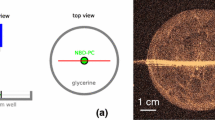Abstract:
A simple model for calculation of the spreading coefficient of an aqueous surfactant solution on an apolar solid is proposed. The spreading coefficient is predicted to have two components: i) the van der Waals component, which is similar to the spreading coefficient of the alkane, making up the surfactant tail; and ii) the monolayer frustration component, dependent on the bending moduli and the spontaneous curvature of the surfactant. The frustration term is minimized at a negative spontaneous curvature. In order for a solution to spread, the van der Waals component of the spreading coefficient must be positive and larger than the monolayer frustration term. The spreading is facilitated by surfactants having very short and branched alkyl tails.
Similar content being viewed by others
Author information
Authors and Affiliations
Additional information
Received 19 May 1999 and Received in final form 29 October 1999
Rights and permissions
About this article
Cite this article
Kabalnov, A. Thermodynamics of superspreading. Eur. Phys. J. E 2, 255–264 (2000). https://doi.org/10.1007/PL00013666
Issue Date:
DOI: https://doi.org/10.1007/PL00013666




